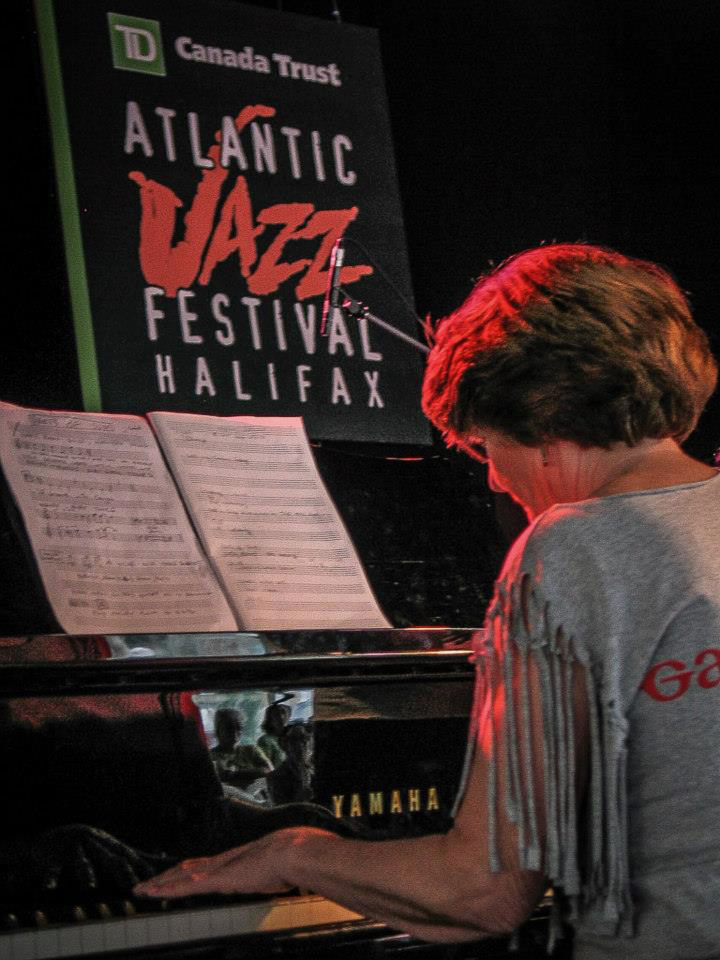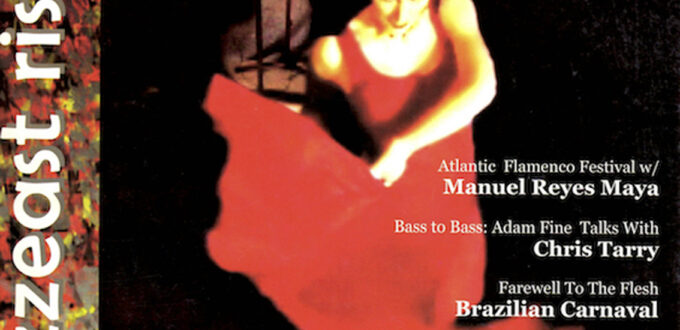By Cheryl Harawitz, published in jazzeast rising, 2006
With a bow that symbolizes the confirmation of our basic goodness and innate intelligence, and in an atmosphere imbued with creativity, the Creative Music Workshop 2006 (CMW) is launched.

My husband, Howard, had been encouraging me to take part in CMW for the past three summers. At the age of 61 I have been playing classical piano for 12 years. My public experience performing music began and ended with a few voice recitals at school during the 1950s along with participation in choirs from time to time since then. As the day grew closer, my fears grew stronger. “If they are mostly young guys in bands I’m not doing it,” I declare to Howard as I head out for the orientation. I get there and indeed it appears that most of the 43 CMW students are young guys in bands, but three hours later I am hooked!
“Music is a great path,” says Jerry Granelli, founder of CMW. “The problem we all have is ego, the ‘I’ that gets in the way of our basic goodness, which is pure awareness,” or, as David Mott puts it, “discursive thinking is the mind’s screensaver. Behind this is pure awareness.“ You are going to be uncomfortable,” Jerry promises. “Everyone is going to have to play an improvised solo as part of this orientation.” As each person nervously gets up to perform their 15 second-plus solo, all six faculty members observe, listen and make notes.
The CMW faculty is an impressive assembly of musicians and artists. It includes drummer, composer, bandleader, and teacher at numerous music colleges in the US, Canada and Europe, Jerry Granelli; composer, saxophonist, music professor and teacher of Martial Arts, David Mott; teacher, performer and international recording artist from Berlin, Christian Kögel; acoustic, electric & piccolo bass artist, J. Anthony Granelli; Saint Francis Xavier University’s jazz faculty instructor, leading east coast acoustic bass player, Skip Beckwith; and slide guitar performer, recording artist and teacher at Berklee College of Music in Boston, David Tronzo. In fourteen days, working at least six hours every day, they provide individual instruction, small group workshops, and intensive ensemble leadership which culminates in a CMW concert that wraps up the Atlantic Jazz Festival in Halifax.
The first three days are spent cutting through our old musical habits and constructs until we are left with nothing but heart and sound. We are asked to play spontaneous solos, duets, and multi-instrumental ensembles improvised around visual images. “Play a mountain,” they say, and “I want you to play yellow, then red then blue,” And somehow, everyone plays beautiful unique compositions. “This is pretty cool,” I’m thinking. “I can do this.”
I am beginning to feel more comfortable. Genuine communication is happening, often through musical moments shared and not spoken of, and a bond of friendship and trust is developing. Defenses weaken, guards are softly lowered and a climate of openness has been established.
Each day begins with Qi Gong instruction from David Mott. Familiar pains in my leg don’t prevent me from participating in the gentle breathing and stretching exercises. It feels good and I keep doing them. By day fourteen, the familiar pains have disappeared. Qi Gong is followed by small group workshops that provide jazz and improvisation theory and exercises, along with individual private instruction in technique. Hey this is cool.
By day four the Jazz festival has kicked off and we have been assigned to one of three ensembles, with two faculty appointed to each. Jerry Granelli and David Mott are working with my group. Visiting musicians from Africa, Brazil, Britain, Europe, and other parts of Canada and the US who are performing at the festival deliver workshops and an opportunity to play with them. Since our CMW fees also include free passes to Jazz festival events, we are able to immerse ourselves in music from every corner of the globe.
By day six I am feeling very tender and vulnerable. I’ve had 2 private jazz theory lessons, one from Skip and another from fellow participant Jeff Torbert. But in trying to avoid familiar chords and sounds using my new ‘pallet of colors’ I end up with nothing but muffled dissatisfying sounds. I have no language. I feel I have nothing to offer and I sit there dribbling out a few notes aimlessly. At one point following a solo improvisation Jerry states, “I want to take Cheryl across the room for ten minutes.” Fear soars and thinking takes over: ‘I know he is going to ask me to leave.’ But in what feels like an eternity but is actually less than a minute, I am relieved. As we walk across the hall, Jerry says, “We are going to do some abstract work at the piano. I want to show you some techniques you can use.” He sits down and makes wonderful sounds using his arms, two fingers, his knuckles. “Now you try” he says and I do. Ten minutes later we join the ensemble. He gestures that I am next for a solo improvisation. It’s no problem. The piano is simply my voice and I use it to sing the freedom I feel. Everyone applauds! When I go home I experiment with my beloved piano and discover sounds I never realized. I feel as though until now I have been on a first date with my instrument.
By day nine ensemble practice is an all day affair through which a performance program emerges and musical milestones are established. As we delve deeper into the process of serving the music, teaching moments reveal themselves and lessons are delivered in the form of story telling. In one session for example, a particular percussion style was needed to serve a blues line in a song. Jerry moves into the drummer’s seat and in ten minutes delivers a sixty year history of jazz, explaining the evolution of the role of the drummer as he effortlessly demonstrates the stylistic forms, “beats”, or “grooves” of the blues, swing, be-bop, hard-bop, post-bop, west coast, and free jazz. He performs for us the techniques and aesthetics of each musical era, introducing drummers such as Paul Motian, Sam Woodyard and others, including himself, along the way, showing us how each was responsible for spawning new interactive rhythmic textures in the world of jazz improvisation.
The difficulty of being in the now, awake and open, repeatedly presents itself. But there is no room for apologies at CMW, not from the faculty for hurt feelings following a critique, nor from students for their false starts and mistakes. The latter are held up for examination only, in a climate of trust and honesty.
By day nine our ensemble has a program assembled and things are going well. Jerry gives us a piece he wrote and asks us to learn it for the concert. The deal is that if anyone doesn’t have it down by Thursday, they won’t be playing that part when we perform. The rhythm is new but I think I have it down. Thursday morning arrives and the “auditions” begin immediately. When it gets to be my turn the notes spill out without conviction. Dave and Jerry are shaking their heads, no, no, no. “You can’t play that rhythm unless you can feel it,” Dave says. “And you’re too nervous to feel it,” Jerry agrees, and we move on to the next person. Only me and one other member of the ensemble will not be playing “Dance With Me.” I am disappointed, hurt and go home to be alone when an unexpected gift awaits me. A workman repairing the windows next door greets me as I enter my house. “Was that you playing the piano earlier? It sounded good. Next time you play, would you leave the window open please?” That afternoon, back in rehearsals I am surprised by a deep rhythmic chugging that’s blazing through my fingers at the keyboard. Inspired by hurt and directed at no one, I learn to recognize it as raw anger. Soon it is over and I am back, ready for more music.
The timing of CMW is no afterthought. Having a pass to music events at the festival serves to enhance the experience and offers an opportunity to immerse oneself in music. For me the music performed by Sanctuary, with David Mott and Jerry Granelli, at Saint Mary’s Basilica on July 18, is forged into my soul along with a handful of lifetime musical experiences that include Murray Schafer’s Music for Wilderness Lake performed at dawn around a lake in Nova Scotia during the early 90’s; the ballet ‘Signes’ choreographed by Carolyn Carlson around paintings by abstract painter Olivier Debré performed at the Bastille Opera House in Paris 2004; and over forty years ago, Tchaikovsky’s 1812 Overture performed at the Royal Albert Hall in London by the Royal Philharmonic Orchestra, the Scottish Military Brass Band, with canon and bells at the end of which 6000 people walked out in total silence, unable or unwilling to pierce the collective feeling of profound sadness the music had brought us to appreciate. Now on a warm summer evening in Halifax, for over an hour I sat with my eyes closed, transported as if on the wings of a butterfly to a world about to be born. At times I could hardly breathe for the sheer beauty and power of the music. At others I felt engulfed in the midst of a gigantic cosmic wave, fearless and in awe.
Finally, the day of the CMW performance arrived. Forty-three musicians I had come to appreciate as highly talented artists gathered in the musician’s arena at the back of the main performance tent. I was confident in my understanding of my musical role. I was determined to make every effort to be awake and mindful of the music being made around me. With the few notes of this new language and a voice to express my heart’s aspiration, I took my place with fellow musicians and let go.
It takes specially gifted teachers with a profound love of music to lead us through such a process. Now I plan to continue to hone new skills, play music with newfound friends and, hopefully, return next year for another CMW experience.

